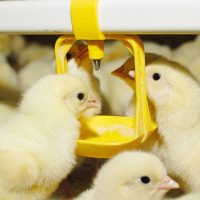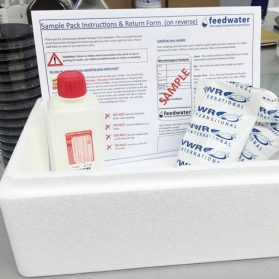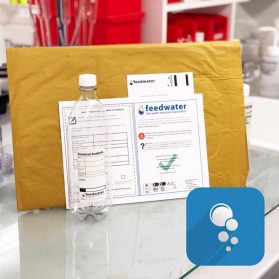Description
Broiler Farm Drinking Water Testing – Chemistry
Poultry can be very sensitive to the chemistry of water with some chemical elements causing diuretic or laxative effect and others upsetting the digestive tract or be unpalatable to the birds causing bitter and unpleasant taste which can slow crop growth.
This product is designed to measure all the parameters which can effect flock performance to give you an idea of potential issues so you can make an informed decision whether to look at filtration or supplementation of the drinking water. Feedwater Ltd is a water treatment company and can assist with both water disinfection and filtration equipment.
The parameters and guidelines mentioned below are taken from educational or authoritative studies on poultry performance to which Feedwater has had no involvement with.
Analysis Includes
- TDS
- Nitrate
- Nitrite
- pH
- Hardness
- Calcium
- Chloride
- Copper
- Iron
- Lead
- Magnesium
- Sodium
- Sulfate
- Zinc
| Parameter | Concentration (ppm) | Comments |
|---|---|---|
| Total Dissolved Solids | 0-1000 | Good |
| 1000-3000 | Satisfactory, although wet droppings may result near the upper limit; performance and health should not be affected. |
|
| 3000-5000 | Poor; wet droppings; increased mortality. | |
| Hardness | <100 (Soft) | No problem. |
| >100 (Hard) | No problem for poultry but interferes with effectiveness of soap, many disinfectants and some medications administered via water. |
|
| pH | 6.0 | Performance problems; corrosion of water system. |
| 6.0-6.4 | Potential problems. | |
| 6.5-8.5 | Recommended for poultry. | |
| >10 | Unsuitable. | |
| Sulphates | 50-200 | May cause laxative effect if Na or Mg>50ppm. |
| 200-250 | Maximum desirable level. | |
| 250-500 | May cause laxative effect. | |
| 500-1000 | Poor; laxative effect but birds may adjust; may interfere with copper absorption; additive laxative effect with chlorides. |
|
| >1000 | Unsatisfactory, increased water intake; wet droppings; health hazard to young birds |
|
| Sodium | 50-300 | Generally no problem; however, may cause loose droppings if sulphate>50ppm or if chloride>14ppm. |
| Chloride | 250 | Highest desirable level; levels as low as 14ppm may cause problems if sodium>50ppm. |
| 500 | Maximum permissible level. | |
| >500 | Laxative; wet droppings; reduced feed intake; increased water intake. | |
| Magnesium | 50-125 | No problem unless sulphate level >50ppm (forms magnesium sulphate which has a laxative effect). |
| >125 | Laxative effect; intestinal irritation if sulphate level is high. | |
| 350 | Maximum. | |
| Calcium | 600 | Maximum level; excessive deposit and scale formation at >600ppm. |
| Nitrate | 10 | Maximum desirable level; however, under certain conditions, levels as low as 3mg/1 may adversely affect performance. |
| Nitirites | Trace | Satisfactory. |
| >Trace | Health hazard (indicates organic material esp. fecal contamination). | |
| Iron | <0.3 | No problem. |
| >0.3 | May encourage growth of iron bacteria which clogs water systems; causes odour, bad taste, precipitate. |
|
| Copper | 0.6 | Higher levels produce a bitter flavour. |
| Lead | 0.02 | Higher levels are Toxic. |
| Zinc | 1.5 | Higher levels are Toxic. |
References
Recommended limits have been recorded from the Poultry Industry Council Canada (E.M Weltzien) Here.
With further information from the College of Agriculture & Life Sciences North Carolina Here.
Some parameters have been excluded if there is debate or conflicting arguments concerning them.
Sample pack contains:
- 1x 1L sample bottle
- 1x return jiffy bag and pre-paid return label
- 1x Analysis sticker to be filled in
You will received a sample pack in the post to take your water sample, you will then be able to return your sample with our prepaid postage label. Analysis will take up to 7 days.
You may also be interested in order a TVC or Full Microbial Potability water analysis.

















